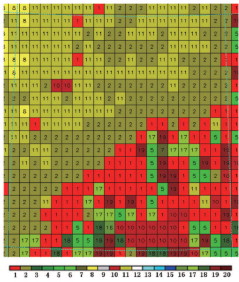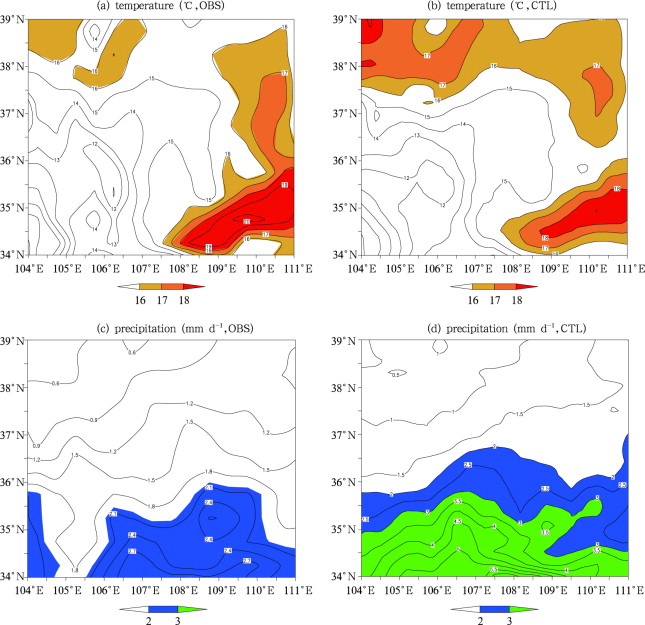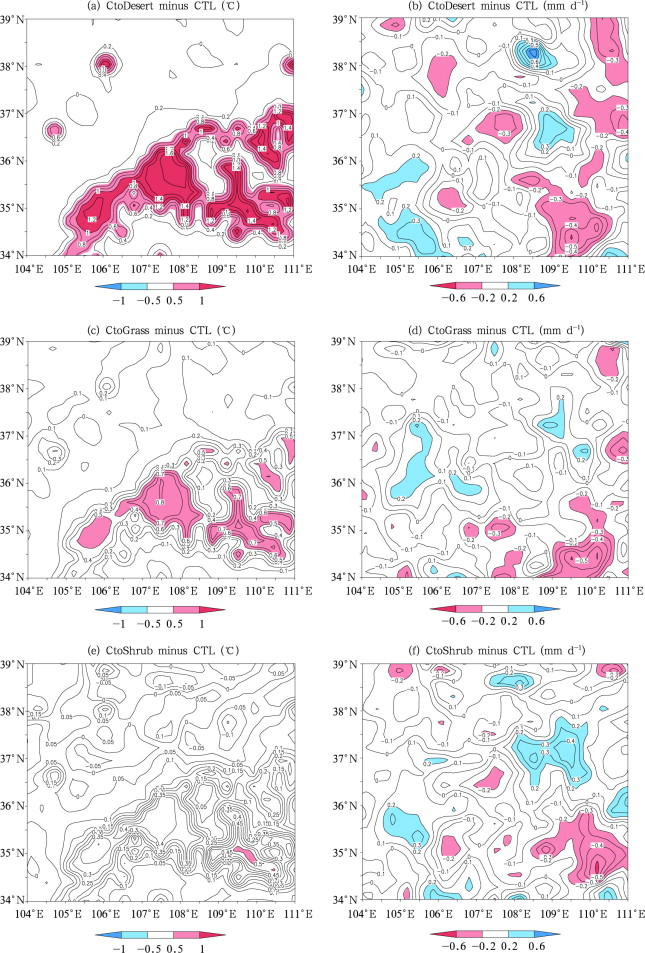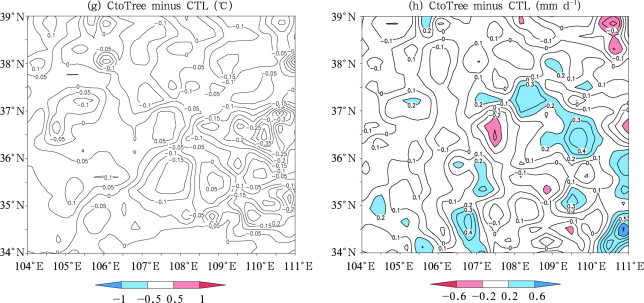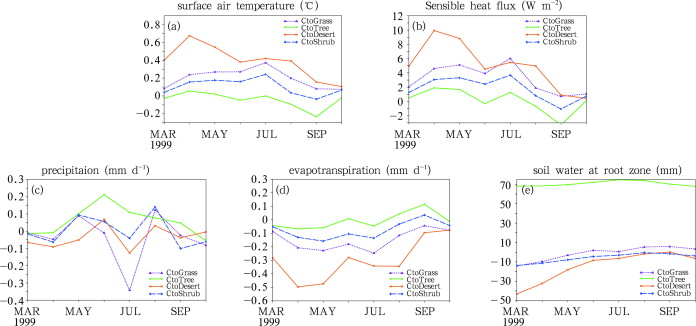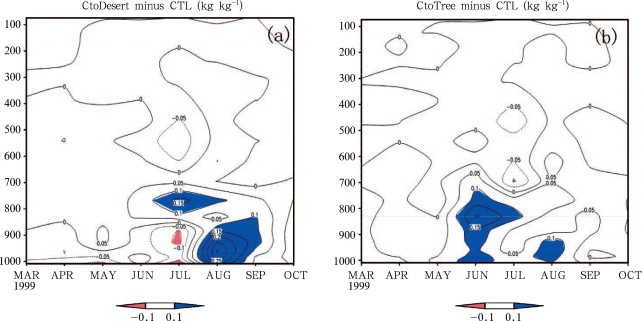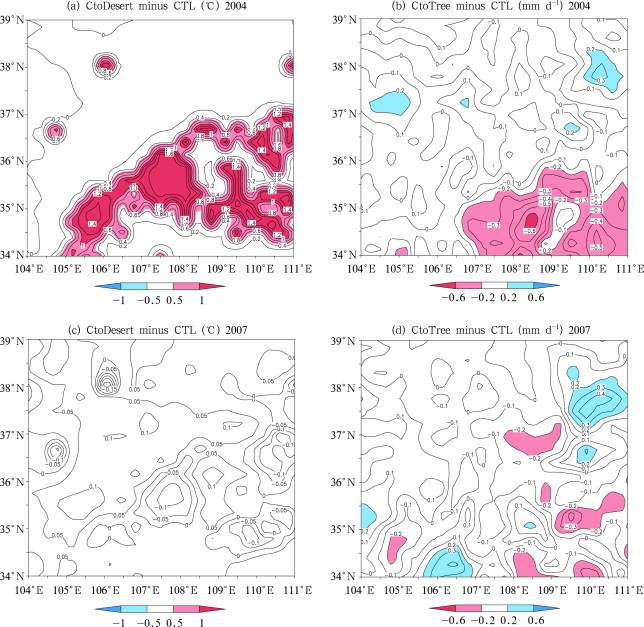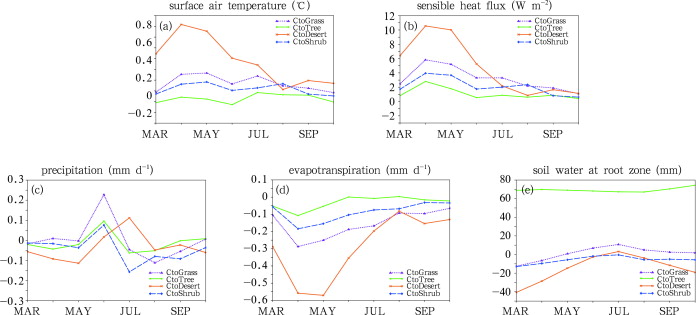Abstract
The impacts of land cover changes on regional climate in Shaan-Gan-Ning (SGN) in western China were simulated with RegCM3. Sensitivity experiments were conducted by replacing crop grids with different new land cover types in the key area of SGN, where the returning cropland to tree/grass project has been carried out since 1999. The modified new land cover types include desert, forest, shrub and grass. They represent degraded, improved, and maintained vegetation cover with natural canopy in the key area. Results from three individual case studies show that the land cover change causes changes in temperature and terrestrial water variables especially within the key area, while changes in precipitation are found for a larger area. The strongest changes appear where the cropland is degraded to bare soil, leading to increasing temperature and decreases in rainfall, evaporation and soil water. Opposite changes occur when cropland changed into forests, especially with strong increases in soil water. When cropland changed to grass and shrub land, the climatic changes are closer to those with forest cover. This shows the importance of improving and maintaining the vegetation in SGN for the ecosystem and regional climate.
Keywords
land cover change ; RegCM3 ; regional climate
1. Introduction
Numerous observation and simulation studies have shown that land cover changes have important consequences for regional climate and ecosystem [ Pielke, 2005 and Gao et al., 2003 ]. Cropland as a special land type related to human activities has also significant impacts on regional climate in various areas worldwide, e.g., in China [ Zhang et al. , 2010 ], India [ Douglas et al. , 2009 ], and the USA [ Cooley et al. , 2005 ].
In this study we focus on typical arid and semiarid areas of western China, called the Shaan-Gan-Ning (SGN), which includes parts of the provinces of Shaanxi and Gansu, and Ningxia Hui autonomous region. The SGN is located at the transition zone from cropland/forest (to the east) to desert (north) and high land (west) areas, and is characterized by water shortages and desertification. Therefore, the Chinese Government has been funding the returning cropland to tree/grass project since 1999. Shi and Wang [2003] investigated possible changes in the regional climate through this project. They concluded that the afforestation and re-greening of deserted land in western China was beneficial to the eco-environment, and the large-scale land cover change in Northwest China may have the effect of adjusting the East Asian monsoon system and regional climates in other parts of China. Observation studies also show that the vegetation has effectively improved or stabilized after the project [ Li et al. , 2010 ].
In order to further understand the effects of different cropland cover changes, numerical simulations have been conducted with the regional climate model RegCM3.
2. Regional climate model and experimental design
The model used in this study is the third generation of the Regional Climate Model (RegCM3), which was developed at the Adbus Salam International Center for Theoretical Physics (ICTP) based on RegCM2 of the U.S. National Center for Atmospheric Research. The detailed information of the model was introduced in Pal et al. [2007] and other related references. RegCM3 has been applied in numerous areas worldwide. In China, it has been used for climate simulations [ Bao et al., 2006 , Gao et al., 2012 and Zhang et al., 2005b ], investigations of land cover and land use change impacts at different scales and regions, such as for the whole China [ Gao et al., 2007 and Yu and Xie, 2012 ], North China [ Zhang et al. , 2005a ], and Sanjiangyuan region in the Qinghai-Tibetan Plateau [ Lian and Shu , 2009 ], with very few studies focusing on the SGN.
The model has 18 vertical levels and a 30 km horizontal resolution. There are totally 65×85 grid points for the key area (34°–39°N, 104°–111°E) of SGN located at the center of the model domain. The land cover types of RegCM3 have been obtained from the Biosphere-Atmosphere Transfer Scheme [ Dickinson and Henderson -Sellers , 1993 ].
Three case years are selected according to their vegetation and climate status. The year 1999, as the reference year, is characterized by low normalized difference vegetation index (NDVI) values. The years 2004 and 2007, with high NDVI values, have different temperature and rainfall conditions (Figures omitted). We hope to find common features of land cover change impacts on the regional climate under different vegetation and climate conditions. For each case, besides the control run (noted as CTL), four sensitivity experiments have been made by replacing the cropland grids of the key area with different land cover types, including desert (type 8 in BATS), deciduous broad tree (5), short grass (2) and deciduous shrub (17). In Table 1 the details of the experiment designs and principles are listed. Totally 15 simulations have been conducted for the numerical investigations.
| Simulation | Experiment description |
|---|---|
| CTL | Control simulation with land cover datasets of USGS |
| CtoDesert | Change the cropland grids into desert at the key area, degrading of LC |
| CtoTree | As CtoDesert, but replace cropland with forest, improving of LC |
| CtoGrass | As CtoDesert, but replace cropland into short grass, maintaining of LC |
| CtoShrub | As CtoDesert, but replace cropland into shrub, maintaining of LC |
Figure 1 shows the land cover type distribution within the key area of SGN, in which crop (red grids) is majorly located in the middle and eastern part. There are totally 78 crop grids that will be converted to different types in the different sensitivity experiments.
|
|
|
Figure 1. Land cover types of the key area (34°–39°N, 104°–111°E). The number inside the grid points denotes the different land cover types. 1-crop/mixed farming, 2-short grass, 3-evergreen needleleaf tree, 4-deciduous needleleaf tree, 5-deciduous broadleaf tree, 7-tall grass, 8-desert, 10-irrigated crop, 11-semi-desert, 16-evergreen shrub, 17- deciduous shrub, 18-mixed woodland, 19-forest/field mosaic. The red grid points denote croplands, which are changed into different land cover types in the following sensitivity experiments |
The integration periods in all experiments are from February 1 to October 31, with the first month being the spin-up. Therefore, the analysis focuses on the period of March–October when crops are growing in the area.
3. Effects of cropland cover change
At first, the RegCM3-simulated climate features in the CTL experiments are evaluated. The used observed monthly temperature and precipitation data-sets are from Xie et al. [2007] and Xu et al. [2009], respectively.
Figure 2 shows the observed and simulated surface air temperature and precipitation of March–October 1999. The temperature is high in the northern and north-eastern parts of the key area and relatively low over the mid-western part. The CTL simulated temperature is overestimated for the north-western part (Fig. 2a&b ). Although the spatial distribution is consistently simulated, the model overestimates the rainfall for the key area (Fig. 2c&d ). This weak simulation has been also reported in other researches and attributed to the convective parameterization schemes in the regional climate model.
|
|
|
Figure 2. Observed (left) and CTL simulated (right) mean surface air temperature (a, b) and precipitation (c, d) of March–October 1999 |
The CTL simulated climate conditions of 2004 and 2007 are generally consistent with the observed, except that the simulated rainfall is overestimated as in the CTL 1999 (Figures omitted). Based on this, the simulation results are used for further sensitivity experiments.
The sensitivity simulations have similar climatic characteristics as the CTL-simulation, which is reasoned due to the land cover being only one of many factors impacting (but not controlling) the regional climate. Hence, the differences between the sensitivity experiments and the CTL-simulation represent the effects of land cover change in this study.
3.1. Land cover change effects in 1999
3.1.1. Spatial distribution of land surface variables
It is obvious that the changes in surface air temperature are generally constrained at the key area where the crop grid points are modified, especially during spring. These changes extend to the neighboring areas in summer and autumn (Figures omitted). In Figure 3 , the mean differences between the sensitivity and the CTL experiments from March to October are presented. The largest increases in temperature (up to 1.6°C) occur in experiment CtoDesert (Fig. 3a ). The temperature is also increasing (up to 0.8°C) in CtoGrass (Fig. 3b ). In CtoShrub, the temperature is increasing at the land cover change area (mostly by less than 0.5°C, Fig. 3c ). Decreasing temperatures are found in CtoTree but with a small intensity (less than 0.3°C decrease in absolute values, Fig. 3d ). At seasonal scale, the changes are generally larger in spring and summer, but small in autumn. Positive temperature differences appear in CtoDesert, CtoGrass, and partly in CtoShrub, while negative changes occur in CtoTree (Figures omitted). So the temperature showed a direct response to the land cover change, it is prone to increase when vegetation is less (CtoDesert), but prone to decrease when vegetation is changed to trees (CtoTree). The inconsistent patterns in CtoGrass and CtoShrub are related to their different physical properties.
Figure 3.
Differences of mean surface air temperature (left, in °C) and rainfall (right, in mm d–1 ) in March–October 1999 between sensitivity and CTL experiments, (a, b) CtoDesert minus CTL, (c, d) CtoGrass minus CTL, (e, f) CtoShrub minus CTL, (g, h) CtoTree minus CTL
Unlike temperature, the changes in rainfall are much more complicated, not only in the spatial patterns, but also in the amounts. The largest modifications occur in summer. The mean differences for March–October 1999 in Figure 3e–g show decreases in rainfall over the south-eastern part of the key area and increases over the mid-western part in three sensitivity experiments, i.e., CtoDesert, CtoGrass, and CtoShrub. Intensive rainfall increases occur in experiment CtoTree (Fig. 3h ). They all show increases to the east of the key (downstream) areas in four sensitivity experiments (Figures omitted). This is similar to responses to other initial conditions, like soil moisture [ Chow et al. , 2008 ], and related to the interactions of land surface and atmospheric processes.
The changes in other land surface variables also show constraining results in the land cover change area. For example, the soil water presents the distinct responses to the land cover change in the key area. The largest water loss appears in CtoDesert, followed by CtoGrass and CtoShrub. The soil water only increases a little in CtoTree (Figures omitted). This means that the improvements of water storage might need a long time period, even with better vegetation conditions.
3.1.2. Temporal changes
To focus on the temporal changes in the key area, we analyze the monthly differences between the sensitivity experiments and CTL in 1999. For the temperature and sensible heat flux (Fig. 4a–b ), the differences are generally large in spring and summer, and small in autumn. They are positive (increasing) in temperature in CtoDesert, fluctuating around zero in CtoGrass, and CtoShrub, and are negative (decreasing) in CtoTree. As to water related variables, rainfall increases in CtoTree in spring and summer, but decreases in CtoGrass and CtoDesert in July (Fig. 4c ). The evapotranspiration shows the largest decreases in CtoDesert from March to October, and is followed by CtoGrass, CtoShrub and CtoTree with lesser magnitude (Fig. 4d ). Particular differences occur in soil water at the root zone (Fig. 4e ). The root zone gains around 70 mm more water in CtoTree shows small losses (about 10 mm) in CtoShrub and CtoGrass, and the largest loss in CtoDesert in March (about 40 mm). The magnitude of soil water change in CtoTree is larger than that in CtoDesert, which implies the importance of tree cover in the SGN.
|
|
|
Figure 4. Temporal changes in surface variable differences between sensitivity experiments and CTL (the former minus CTL) in March–October 1999, (a) surface air temperature, (b) sensible heat flux, (c) precipitation, (d) evapotranspiration, and (e) soil water at root zone |
3.1.3. Changes in atmosphere
The changes in land surface variables will also impact the vertical atmospheric circulations through the re-allocations of energy and water components. Some distinct regional differences exist. From March to October, the temperature increases significantly below 850 hPa in CtoDesert, but slightly decreases below 700 hPa in CtoTree. Slight increases in vertical temperatures also appear in CtoGrass and CtoDesert during spring and summer (Figures omitted).
Figure 5 presents the vertical profiles of monthly water vapor differences of the two extreme sensitivity experiments (CtoDesert and CtoTree) and CTL. There is a shallow decreasing layer (below 900 hPa) in July in CtoDesert (Fig. 5a ) and a deeper increasing one (below 700 hPa) in June in CtoTree (Fig. 5b ). This is related to the loss (gain) in water supply from the land surface and soil, and will impact the precipitation characteristics via processes within the atmosphere.
|
|
|
Figure 5. Vertical profiles of water vapor differences between both CtoDesert (a) and CtoTree (b) with CTL from March to October in 1999 |
For most surface variables, the impact intensity of land cover change is the largest in CtoDesert, followed by CtoGrass, CtoShrub and CtoTree. The changes in CtoTree are generally opposite (with weaker intensity) to those in CtoDesert. But the change in the soil water of the root zone is an exception, where the changes due to land cover change are larger in CtoTree than in CtoDesert, which is very important to protect and improve the ecosystem of the SGN.
3.2. Land cover change impacts in 2004 and 2007
The differences between the sensitivity experiments and CTL are also analyzed for 2004 and 2007. They show generally consistent spatial and temporal features as for 1999, so only the mean differences of the two years between the sensitivity experiments and CTL are presented in this section.
As shown in Figure 6 , the surface air temperature significantly increases in the land cover change area in CtoDesert (mostly > 0.5°C, Fig. 6a ), but slightly decreases in CtoTree (Fig. 6c ). In CtoDesert, the rainfall decreases in the south-eastern part, but increases in the north-western and north-eastern part of the key area (Fig. 6b ). In CtoTree, the areas with decreasing precipitation are getting smaller, while increases are located in the north-eastern and south-western parts in the key area (Fig. 6d ).
|
|
|
Figure 6. Differences of mean surface air temperature (left) and rainfall (right) between the sensitivity and CTL experiments in 2004 and 2007, (a, c) CtoDesert minus CTL, (b, d) CtoTree minus CTL |
The mean temporal changes in various land surface variables for 2004 and 2007 are shown in Figure 7 . Although the differences between the sensitivity experiments and CTL show some discrepancies in their magnitude, by comparing them with those in 1999, they possess consistent features. For example, the largest impacts occur in CtoDesert when replacing cropland with desert. Here, the temperature (Fig. 7a ) and sensible heat flux (Fig. 7b ) are increasing in spring and summer, while evapotranspiration and soil moisture (Fig. 7d&e ) are decreasing. The differences in precipitation are the most significant in summer in CtoGrass (Fig. 7c ), again reflecting that the rainfall characteristics as response to land cover change are non-linear and case-dependent.
|
|
|
Figure 7. Same as Figure 4 , but for the mean differences of 2004 and 2007 between all sensitivity experiments and CTL from March to October |
Consequently, different cropland cover changes show various consequences, in which the worst is the degradation of vegetation (CtoDesert). The processes potentially involved are related to energy and water changes. The degradation of cropland can cause the land surface and overlying atmospheric temperature to increase, which might influence the wind velocity, etc. At the same time, the soil moisture (especially that of the root zone) and evapotranspiration are decreasing, which leads to fewer water supplies to the atmosphere, and hence tempers with rainfall characteristics. In contrast, a better vegetation cover (like in CtoTree) leads to decreases in temperature and sensible heat flux in spring and summer, and most important, increases the soil moisture effectively, which is crucial for the ecosystem and moisture supply to the atmosphere. The introduced experiments prove the key role of vegetation protection and improvement in the SGN.
4. Conclusions and discussion
The RegCM3 simulations have shown that different cropland cover changes have various effects on the regional climate of the Shaan-Gan-Ning area. In summary: 1) The most obvious impacts of land cover change appear in spring and summer temperature, especially with the degradation of cropland to semi-desert (CtoDesert). 2) The changes in temperature and soil water are constrained within the key area as direct responses of land cover change, while those in precipitation are extending to the whole domain. 3) The changes in experiment CtoTree are generally opposite to those in experiment CtoDesert but with less intensity or magnitude, while those in experiments CtoGrass and CtoShrub range between them.
The numerical experiments in this study focus on the impacts of changes in one particular land cover type (crop), and the land cover change is set artificially with no consideration of the remote sensing observations. Further investigations and statistical diagnostics in the mechanisms of the land cover change impacts are needed. Additionally, only three case years have been studied for the land cover change effects, while continuous integrations for multi-year would guarantee more reasonable statistical significance. Finally, the impacts of cropland changes on the regional climate in this study have been realized only by the use of some assigned parameters (i.e., roughness length and conductance coefficients), but do not include the dynamical crop processes (as in Chen and Xie [2012] ). By using updated regional climate models with improved dynamical vegetation processes in the near future, we will get more detailed information on the impacts of land cover change on the regional climate.
Acknowledgements
The authors are very grateful to the anonymous reviewers and editors for their constructive comments and suggestions. The study was jointly supported by the Special Research Program for Public-Welfare Forestry (No. 200804001), Meteorology (No. GYHY2011060114-3), and the 863 Project (No. 2009AA122005).
References
- Bao et al., 2006 Y. Bao, S.-H. Lü, D.-R. Lu, et al.; Application of regional climate model (RegCM3) in Northwest China I: Simulation of an arid extreme event; Journal of Glaciology and Geocryology (in Chinese), 28 (2) (2006), pp. 164–174
- Chen and Xie, 2012 F. Chen, Z.-H. Xie; Effects of crop growth and development on regional climate: A case study over East Asian monsoon area; Climate Dynamics, 38 (2012), pp. 2291–2305
- Chow et al., 2008 K.C. Chow, J.C.L. Chan, X.-L. Shi, et al.; Time-lagged effects of spring Tibetan Plateau soil moisture on the monsoon over China in early summer; International Journal of Climatology, 28 (1) (2008), pp. 55–67
- Cooley et al., 2005 H.S. Cooley, W.J. Riley, M.S. Torn, et al.; Impact of agricultural practice on regional climate in a coupled land surface mesoscale model; Journal of Geophysical Research, 110 (2005) http://dx.doi.org/10.1029/2004JD005160 D03113
- Dickinson and Henderson-Sellers., 1993 R.E. Dickinson, A. Henderson-Sellers; Biosphere Atmosphere Transfer Scheme (BATS1e) version as coupled to the NCAR Community Climate Model; NCAR Technical Note, NCAR/TN-387+STR (2005), p. 72
- Douglas et al., 2009 E.M. Douglas, A. Beltran-Przekurat, D. Niyogi, et al.; The impact of agricultural intensification and irrigation on land-atmosphere interactions and Indian monsoon precipitation: A mesoscale modeling perspective; Global Planetary Change, 67 (2009), pp. 117–128
- Gao et al., 2003 X.-J. Gao, Y. Luo, W.-T. Lin, et al.; Simulation of effects of land use change by a regional climate model; Advances in Atmosphere Sciences, 20 (4) (2003), pp. 583–592
- Gao et al., 2012 X.-J. Gao, Y. Shi, D.-F. Zhang, et al.; Climate change in China in the 21st century as simulated by a high resolution regional climate model; China Science Bulletin, 57 (5) (2012), pp. 374–381
- Gao et al., 2007 X.-J. Gao, D.-F. Zhang, Z.-X. Chen, et al.; Land use effects on climate in China as simulated by a regional climate model; Science in China Series D: Earth Sciences, 50 (4) (2007), pp. 620–628
- Li et al., 2010 D.-K. Li, H.-J. He, A.-L. liu; Impact of human activities and climate change on vegetation around HongjianNur Lake in Northwestern China; Journal of Desert Research (in Chinese), 30 (4) (2010), p. 831836
- Lian and Shu, 2009 L.-S. Lian, J. Shu; Simulation of effects of grassland degradation on regional climate over Sanjiangyuan region in Qinghai-Tibet Plateau; Acta Meteorologica Sinica, 23 (3) (2009), pp. 350–362
- Pal et al., 2007 J.S. Pal, F. Giorgi, X.-Q. Bi, et al.; Regional climate modeling for the developing world: The ICTP RegCM3 and RegCNET; Bulletin of Atmosphere and Meteorology Society, 88 (2007), pp. 1395–1409
- Pielke, 2005 R.A. Pielke; Land use and climate change; Science, 310 (9) (2005), pp. 1625–1626
- Shi and Wang, 2003 W.-L. Shi, H.-J. Wang; The regional climate effects of replacing farmland and re-greening the desertification land with forest or grass in West China. Advances in Atmosphere Sciences, 20 (1) (2003), pp. 45–54
- Xie et al., 2007 P.-P. Xie, A. Yatagai, M.-Y. Chen, et al.; A gauge-based analysis of daily precipitation over East Asia; Journal of Hydrometeorology, 8 (2007), pp. 607–626
- Xu et al., 2009 Y. Xu, X.-J. Gao, Y. Shen, et al.; A daily temperature dataset over China and its application in validating a RCM simulation; Advances in Atmospheric Sciences, 26 (4) (2009), pp. 763–772
- Yu and Xie, 2012 Y. Yu, Z.-H. Xie; A simulation study on climatic effects of land cover change in China; Adv. Clim. Change Res., 4 (2) (2012), pp. 117–126
- Zhang et al., 2010 D.-F. Zhang, X.-J. Gao, Y. Shi, et al.; Agricultural land use effects on climate over China as simulated by a regional climate model; Acta Meteorologica Sinica, 24 (2010), pp. 215–224
- Zhang et al., 2005a D.-F. Zhang, X.-J. Gao, Z.-C. Zhao, et al.; Simulation of climate in China by RegCM3; Advances in Climate Change Research (in Chinese), 1 (3) (2005), pp. 119–121
- Zhang et al., 2005b J.-Y. Zhang, W.-J. Dong, C.-B. Fu; Impact of land surface degradation in northern China and southern Mongolia on regional climate; China Science Bulletin, 50 (1) (2005), pp. 75–81
Document information
Published on 15/05/17
Submitted on 15/05/17
Licence: Other
Share this document
Keywords
claim authorship
Are you one of the authors of this document?
